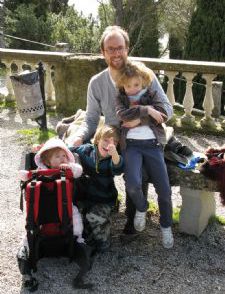Last autumn, having just arrived in Florence, I was walking through the city with some colleagues of my wife, all Renaissance scholars. Noticing the glass façade of the restaurant Alle Murate, I remarked, ‘Oh, that’s where it is.’ ‘Have you not been there yet?’ they answered in unison. ‘No, have you?’ I replied. ‘Yes, we went last week.’ ‘How was the food?’ I inquired.
‘Oh we didn’t eat there; we just went to look at the frescoes,’ they replied.
The company I have kept this last year may have been unusually rife with Renaissance academics, but exchanges such as this one are pretty commonplace. The supposition is that we are visiting for the art and the history that goes with it. The guidebooks and postcards make it clear that this is what you come to Florence for. However, not all of us come to look at frescoes and palazzi.
Before this year, my memories of my one previous visit amounted to little more than David, bistecca, Chianti, and the two precious Smiths vinyl bootlegs I brought home in my impractical antique suitcase. Seemingly, I have not changed much in the intervening 20 years, because the memories I’m taking home this year will again have little to do with Florence’s historical and artistic treasures.
Is this a bad thing? Many of us like to travel because we like to be in places that are just … foreign. It may be that visiting the Uffizi or the Palazzo Pitti gives your trip a focal point, but the journey, the lunch that you stop for or the local people you observe on the way should be as much a part of that trip as the visit to the sites themselves.
So, if you decide to go and see Fra Angelico’s frescoes at San Marco, grab some schiacciata at Pugi first, or jump on a bus that’s filled with school kids on their way home from the liceo. Being swamped by the local population chatting loudly on a busy bus or in a queue at the swimming pool is often more exhilarating than gazing aimlessly at a painting of the Deposition, guidebook in hand.
For a break from the weighty cultural history on offer in the city, head out to I Gigli, the large shopping mall past the airport. Here, there are no tour guides with brightly coloured umbrellas raised aloft, escorting confused-looking tour groups-only Florentines arguing at length over which cell phone or McBurger to buy. I guarantee that you will get a better idea of what the Florentines are like here than you will standing in a queue for the Uffizi. You will get a snapshot of Italian life that is not captured and printed, then put on sale with the other postcards at every corner shop in the city center.
Another must for the visiting philistine in Florence are the markets. It may sound glib, but the Mercato Centrale and Mercato Sant’Ambrogio were my Uffizi and Accademia. The colours, bustle, smells, and life at these places are as rewarding a visit as any Botticelli. And you get to eat what you are looking at, too! Both markets have their share of snap-happy tourists, so if you are really intrepid, you could head out to a suburban branch of Esselunga or COOP to see where the majority of Florentines do their food shopping.
A memory that will take some beating for me was a trip to see Fiorentina play at the Artemio Franchi stadium. Judging by the number of American accents heard at the Fiorentina vs. Roma match, a visit to Campo di Marte is now firmly established as a must-do for U.S. undergrads. Not that this detracted from the experience in any way. The chanting can only be described as Italian, as are the insults shouted at the referee.
Try and grab a seat near the Curva Fiesole to get the full Viola experience.
The packed traffic-free streets after the match, thronging with (albeit disgruntled) Fiorentina fans were a highly atmospheric place to be. Being literally surrounded by animated Italian football fans made me feel happily cut off from the tourist-dense heart of the city. That place at that time will be an abiding memory of Florence for me.
A 10-minute walk from the stadium is one of Florence’s best gelaterie, Badiani. (Incidentally, there is no answer to the question as to which is the best). If you are going to visit Badiani (and you must) then do so late in the evening. After a Fiorentina match is ideal, when this up-market gelateria is at its busiest with Florentines from all walks of life.
In a previous life, my first great love was pop music, and though other Italian cities seem to attract more bands, I managed to see two great acts in quite remarkable settings in Florence: Wilco at the Teatro della Pergola, and English folk act The Unthanks in the Convento di Santa Maria del Carmine, the latter a breathtaking setting for the haunting English folk harmonies, yet a place I would never otherwise have visited.
In a sense, these gigs are emblematic of what Florence has to offer. It may well be presented as a collection of famous buildings and paintings to be ticked off the tourist’s list, but it is when contemporary life is backdropped by the historic buildings or artworks that Florence really enthralls.
Philistines: A person who is hostile or indifferent to culture and the arts.(Concise Oxford English Dictionary, 11th edition)





